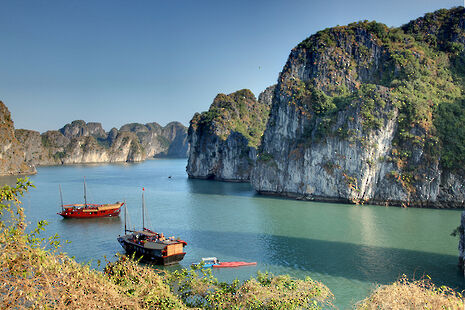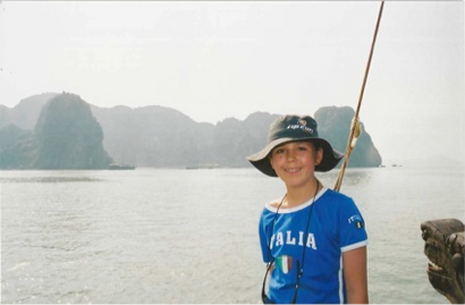The Bucket List: Halong Bay
In her latest column, Gabrielle Watts take us to beautiful Halong Bay, Vietnam

If you’ve ever seen the Disney film, Brother Bear, you might recall a scene where two thuggish mountain goats are interrupted in their flamboyant brawling by their own echoes. The pair, which had been attempting to seduce an unimpressed lady-goat, become so distracted by their echoes that we see them later as evening falls, still there, shouting, “No you shut up” at the ringing mountains. It’s funny, and it’s silly, and it works. This being said, you don’t expect echoes quite so coherent nor so clear in reality. What you get instead, more generally, is a weird, warbling sound that needs some examination in order to be realised as a repetition of what you’d said. This is not the case in Halong Bay, Vietnam. There, the echoes could well have been made for comic effect in a cartoon, and for a while my brother and I, jumping off the sloop on which we were sailing for the day, were convinced that there was another family just around the next island. When we realised that what we were hearing were in fact remarkably clear, loud echoes of ourselves, naturally it was necessary to re-enact the goat scene.
Halong Bay consists of more than 1600 largely uninhabited precipitous limestone islands. It is a UNESCO World Heritage site, on the grounds of its exceptional geomorphology, which is to say in layman’s terms that the sea has done cool things to the limestone, like making arches and towers, and that those things can tell us a lot about the world’s geo-climatic history.
Legendarily speaking, a local folk tale in Vietnam concerning the bay says that it was actually created by a great dragon from the mountains. Giving a perfect lesson on the hazards of low-level flying, it is said that the dragon tumbled out of the mountains in the Cao Bang province: a world of caves, waterfalls and lakes surrounded by white trees on the border with China. On its lurching, perilous way, the dragon’s tail is said to have gouged out valleys and crevasses, until eventually, exhausted, it tumbled into the sea, and now all that is left are the limestone islands that one presumes are its spine, scales, and assorted monstrous protrusions. The name, ‘Halong’ literally translates as ‘where the dragon descends into the sea’, and, all joking aside, it’s easy to understand why anyone would see this as a place of wonder.
Indeed, the bay has already made it into our popular imagination, whether we’re aware of it or not, via the James Bond film Tomorrow Never Dies. In the film, Bond and his partner of the moment, the especially badass Wai Lin, venture to the bay in order to foil media mogul Elliot Carver’s plans to begin World War III. Of course, they win, and sail away on a beautiful wooden ship not unlike the one from which my brother and I were jumping, before he indulged in the on board buffet and developed what looks like a lifelong distaste for seafood. As it happens, what is called Halong Bay in the film is actually filmed in Phuket, Thailand. Still, if the name was ringing a bell, it may well be thanks to the globe-hopping adventures of 007.

I’m biased, it’s true, but I would say that the best way to experience what is truly a jaw-dropping landscape is by ship. The islands stretch further than you could imagine from the shore, climbing in staggered turrets of stone, clothed by the rich warm greens of tropical trees. They unfold across the sea: impossible arches and trembling towers like a quiet, ringing city of stone set into the ocean. It’s Vietnam, so if it’s anything like it was since the month I spent there when I was 10, the food will be fresh, sweet and delicious, the locals will be polite and kind, and the sunshine will be warm and golden. A blessing of seeing an area like this is that it’s not too often that the weather becomes too hot, the islands provide necessary shade, and the air is perfumed by the salt of the sea. The city on the harbour is quickly left behind, and it won’t be long before you think yourself blessedly alone beneath the birds, trees and island mountains, which can climb as far as 100 metres from sea level.
Halong Bay is very old, but unlike other places, it’s rather robust too: for example, it is not at all problematic for two children to jump off the side of a ship to their hearts' content. It’s popular with tourists but it’s not crowded: I recall seeing perhaps three other ships, and one of those was a fishing boat. Its attraction is perhaps less spectacular than its man-made competitors on this list, but it’s here because first, you might not have known it, and second, I cannot remember having visited anywhere more peaceful. You can go here to rest, indulge, and play in the ocean. To crane your neck and wonder at the apparently endless beauty the world has to offer. It’s somewhere to recollect that in the grand scheme of things, you needn’t loom so very large, and that there is always time to drop your burdens by the wayside, if only while the echoes last.
 News / Copycat don caught again19 April 2024
News / Copycat don caught again19 April 2024 News / Emmanuel College cuts ties with ‘race-realist’ fellow19 April 2024
News / Emmanuel College cuts ties with ‘race-realist’ fellow19 April 2024 Theatre / The closest Cambridge comes to a Drama degree 19 April 2024
Theatre / The closest Cambridge comes to a Drama degree 19 April 2024 News / Acting vice-chancellor paid £234,000 for nine month stint19 April 2024
News / Acting vice-chancellor paid £234,000 for nine month stint19 April 2024 Interviews / ‘People just walk away’: the sense of exclusion felt by foundation year students19 April 2024
Interviews / ‘People just walk away’: the sense of exclusion felt by foundation year students19 April 2024




